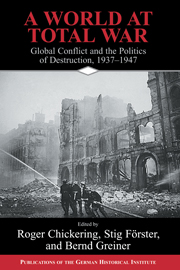Are We There Yet? World War II and the Theory of Total War
Published online by Cambridge University Press: 05 January 2013
Summary
In the vast library that now houses the historical literature on World War II, the volume that Gordon Wright published more than forty years ago occupies a special place. It is one of the shortest books in the entire collection. It is also perhaps the most comprehensive survey ever published on the war in the European theater. It ranges over military operations, the diplomacy of war, the mobilization of economies and popular morale, occupation and resistance, psychological warfare, the harnessing of science and technology to destruction, and the war's revolutionary impact on society and culture. The volume is remarkable in an additional respect. Although it bears the title The Ordeal of Total War, it proffers neither a sustained discussion nor a definition of this pivotal term. Instead, it appears to argue by implication that World War II was paradigmatic, that the defining feature of total war was the very enormity of its scope and impact, and that such a degree of comprehensiveness made this conflict a singular phenomenon in military history.
This is a defensible argument that other historians of the Second World War have embraced in the same axiomatic spirit, which has had to work in lieu of analytical reflection.2 However, at the conclusion of a series of volumes on total war, it seems appropriate to reexamine some of the premises of this argument. Defining the Second World War as the paradigmatic instance of total war has important methodological ramifications, which pertain above all to issues of narrative logic. The central analytical questions revolve around the degree to which this war resembled its predecessors – particularly, given the purview of this series of volumes, the American Civil War and the First World War.
- Type
- Chapter
- Information
- A World at Total WarGlobal Conflict and the Politics of Destruction, 1937–1945, pp. 1 - 16Publisher: Cambridge University PressPrint publication year: 2004
- 2
- Cited by



